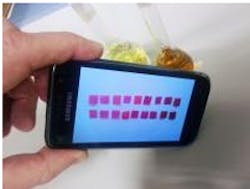Spanish sensor checks for mercury
Chemists at the University of Burgos (Burgos, Spain) have manufactured a sensor that changes color in the presence of water contaminated with mercury.
The sensor consists of a material that contains a florescent organic compound called rhodamine. While rhodamine is insoluble in water, it has been chemically fixed to a hydrophilic polymer structure in such a way that, when put into water, the sensory molecules are forced to remain in the aqueous medium and interact with any mercury that is present.
"Changes can be seen by the naked eye and anyone, even if they have no previous knowledge, can find out whether a water source is contaminated with mercury above determined limits," says researcher José Miguel García.
In addition, the researchers have written a program that can run on a mobile phone or tablet computer that can analyze the colors found in images taken of the sheet to determine the specific concentration of the metal.
The exact composition of the material can be adjusted to meet specific parameters. Presently, the researchers have calibrated the sheet so that it changes color when limits of mercury established by the US Environmental Protection Agency (EPA) are exceeded in water destined for human consumption.
Related articles from Vision Systems Design you might also find of interest.
1. iPhone app helps farmers manage fruit pickers
A new iPhone app called BucketLoad aims to help farmers manage teams of individuals who hand-pick crops such as blueberries, strawberries and citrus fruit during the harvest season.
2. Software transforms iPhone into a 3-D scanner
A researcher from the Georgia Institute of Technology (Atlanta, GA, USA) has developed a software app that can transform the iPhone into a 3-D scanner.
3. iPhone app cooks up ideas from labels
A new iPhone application uses automatic image recognition to identify branded food products and recommend recipes that can use them.
-- Dave Wilson, Senior Editor, Vision Systems Design
